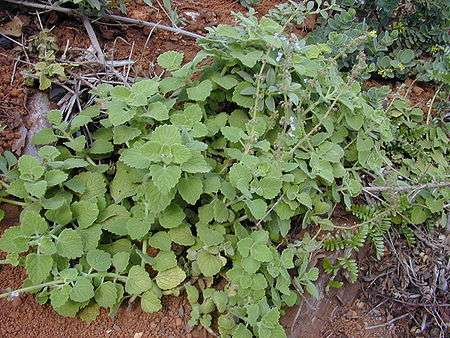Plectranthus
Plectranthus, with some 350 species, is a genus of warm-climate plants occurring largely in the Southern Hemisphere, in sub-Saharan Africa, Madagascar, India and the Indonesian archipelago down to Australia and some Pacific Islands. They are closely related to Solenostemon and are known as the spurflowers. Several species are grown as ornamental plants, as leaf vegetables, as root vegetables for their edible tubers, or as medicine.[2]
| Plectranthus | |
|---|---|
 | |
| Flowers of Plectranthus fruticosus | |
| Scientific classification | |
| Kingdom: | Plantae |
| Clade: | Tracheophytes |
| Clade: | Angiosperms |
| Clade: | Eudicots |
| Clade: | Asterids |
| Order: | Lamiales |
| Family: | Lamiaceae |
| Subfamily: | Nepetoideae |
| Tribe: | Ocimeae |
| Genus: | Plectranthus L'Hér.[1] |
| Species | |
|
Many, see text | |
| Synonyms[1] | |
|
Ascocarydion G.Taylor | |
Plectranthus species are used as food plants by the larvae of some Lepidoptera species including the engrailed (Ectropis crepuscularia).
Many plants called coleus actually belong to this genus, as Coleus is no longer recognized.
Selected species
|
|
Formerly described as Plectranthus
- Anisochilus carnosus (L. f.) Wall. ex Benth. (as P. strobilifer Roxb.)
- Isodon coetsa (Buch.-Ham. ex D.Don) Kudô (as P. coetsa Buch.-Ham. ex D.Don)
- Isodon inflexus (Thunb.) Kudô (as P. inflexus (Thunb.) Vahl ex Benth.)
- Isodon lophanthoides (Buch.-Ham. ex D.Don) H.Hara (as P. striatus Benth.)
- Isodon rugosus (Wall. ex Benth.) Codd (as P. rugosus Wall. ex Benth.)
- Isodon sculponeatus (Vaniot) Kudô (as P. sculponeatus Vaniot)[5]
References
- "Genus: Plectranthus L'Hér". Germplasm Resources Information Network. United States Department of Agriculture. 2007-10-05. Archived from the original on 2011-06-29. Retrieved 2011-02-17.
- Catherine W. Lukhobaa; Monique S.J. Simmonds & Alan J. Paton (3 January 2006). "Plectranthus: A review of ethnobotanical uses". Journal of Ethnopharmacology. 103 (1): 1–24. doi:10.1016/j.jep.2005.09.011. PMID 16289602.
- "Plectranthus". Australian Plant Name Index (APNI), IBIS database. Centre for Plant Biodiversity Research, Australian Government, Canberra. Retrieved 2009-02-03.
- Bussmann R. W.; et al. (2006). "Plant use of the Maasai of Sekenani Valley, Maasai Mara, Kenya". J Ethnobiol Ethnomed. 2: 22. doi:10.1186/1746-4269-2-22. PMC 1475560. PMID 16674830.
- "GRIN Species Records of Plectranthus". Germplasm Resources Information Network. United States Department of Agriculture. Retrieved 2011-02-17.
External links
| Wikimedia Commons has media related to Plectranthus. |
| Wikispecies has information related to Plectranthus |
- " Multilingual taxonomic information". University of Melbourne.
- EcoPort on P. rotundifolius
- PROTAbase on P. rotundifolius synonym for Solenostemon rotundifolius
- EcoPort on P. esculentus (with tuber photo)
- Lamiales Newsletter on P. esculentus
- Little-known African Tubers (discusses P. rotundifolius and P. esculentus)



